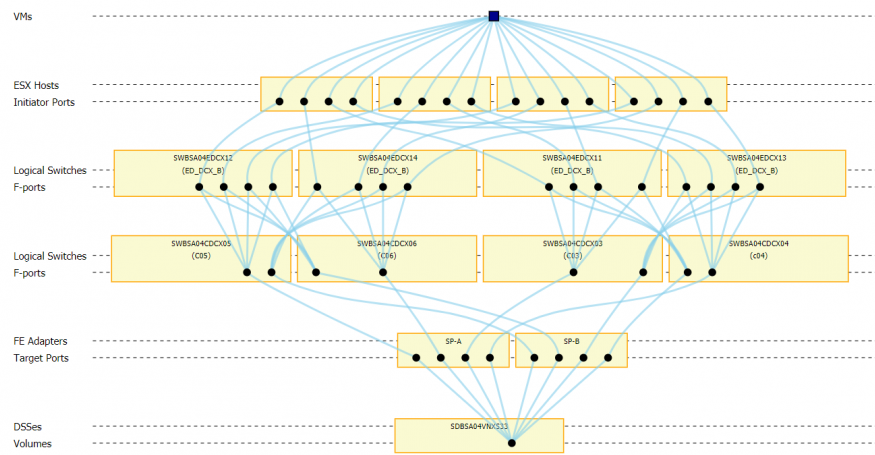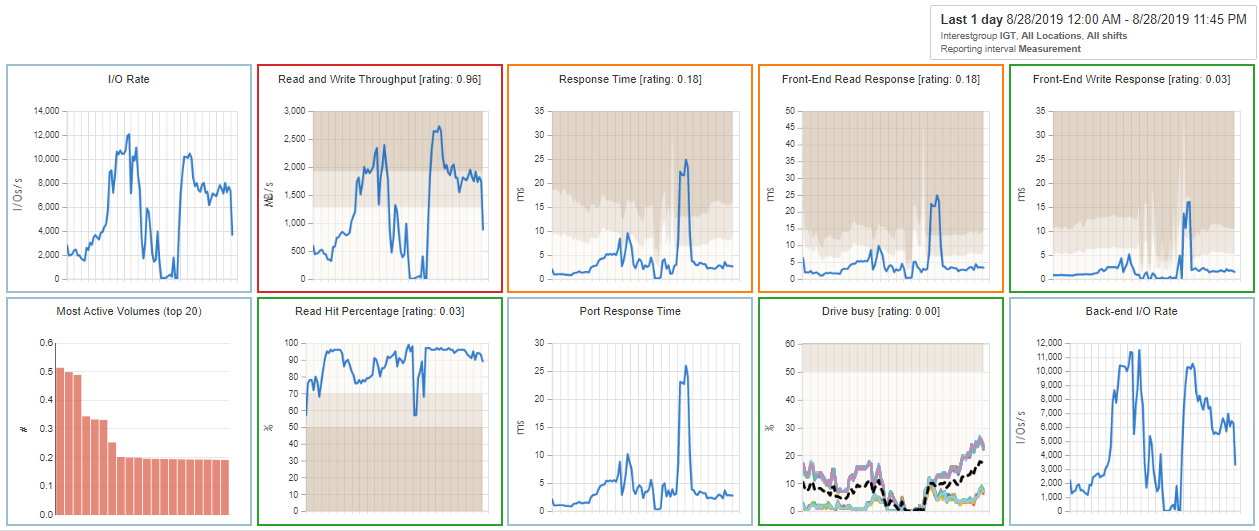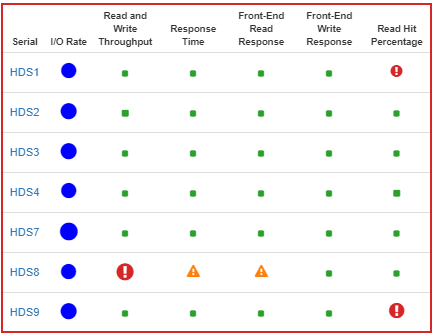IBM Spectrum Virtualize, SVC
Performance Management for IBM Spectrum Virtualize, SVC and Storwize
Monitor the performance, capacity & configuration of your multi-vendor SAN infrastructure in a single view.
Reduce your costs and mean time to resolution, and safely get the most value out of your SAN infrastructure with built-in architecture specific intelligence and statistical anomaly detection.
Stop jumping around between multiple tools and manually correlating data from different devices when trying to diagnose performance or configuration issues.
Leverage domain specific artificial intelligence to improve IT operations in the areas of storage infrastructure performance, capacity, and configuration management.
IntelliMagic Vision provides highly refined and interpreted information about your storage infrastructure to help prevent performance outages, resolve performance issues, optimize your storage infrastructure, and elevate storage infrastructure visibility.
See our latest webinar led by Evaluator Group Senior Analyst, Randy Kerns focusing on the business value of resiliency and optimization by deploying more intelligence and automation for Enterprise Storage operations.
Automated Health Insights leverage hardware-specific AIOps functions to identify and prevent the most common storage and fabric performance and capacity issues.
Health Insights include time, multiple metrics, multiple components, and AI-rated metrics in a single view to provide preventive focused insights. In this case, this system is showing throughput constraints, front-end response time, front-end read response time and port read response time issues, indicating serious performance risk.
Advanced statistical functions provide performance and capacity anomaly detection. This allows you to not only see what has changed, but also determine the magnitude and significance of that change.
IntelliMagic Vision’s Change Detection functions automatically identify significant workload changes in your Storage, Host (Cluster), Virtual Machine and Switch port environment so that you can investigate anomalies before they impact shared resources in the environment.
Capacity forecasting leverages AIOps functions to understand future storage capacity requirements and prevent capacity constraints.
IntelliMagic tracks key capacity metrics over time and calculates the consumption rate over time to provide a comprehensive view of the capacity growth and free space expiration at a storage system and storage pool level.
The number of days until running out of space can be leveraged to purchase more storage for the impacted storage system.
See for yourself why leading companies are saying “I don’t know how to live without IntelliMagic Vision.” Whether you’re evaluating competitive solutions or trying to solve a problem, we’re happy to help you move forward with your IT initiatives.
Constructed topology views compares actual topology to best practices to identify orphaned ports, orphaned volumes, asymmetrical connectivity, single paths for ESX host and masking views, data issues and others.
Configuration analytics visually constructs all of the hosts connected through the fibre channel fabric from the VMware guest to the back-end storage LUN and its associated disk drives and offers interactive drill downs and descriptions to easily learn and investigate.
Leverage IntelliMagic Vision via secure SaaS cloud delivery to quickly gain the benefits of AIOPs for your storage infrastructure with minimal cost, commitment, and effort, and maximum benefits.
Seamlessly and securely share custom reports, dashboards, and links to increase real-time collaboration and elevate team impact.



Performance Management for IBM Spectrum Virtualize, SVC and Storwize
IntelliMagic Vision collects measurement data from the storage arrays and SAN switches and supports the following platforms, attached to any host type such as Linux, Unix, AIX, Windows, VMware, etc.
IntelliMagic Vision uses various API’s and native CLI commands to collect data from the storage arrays and switches.
Discuss your technical or sales-related questions with our availability experts today
Most IT professionals probably know what is SAN storage and how it works. SAN stands for storage area network. It’s simply a network that’s designed to store data. Companies that use a SAN know that one should be correctly set up from the beginning in order to prevent any performance issues down the line. If a SAN doesn’t perform as well as it should, then companies won’t be able to do their jobs as well as they can, potentially losing business and revenue.
Setting up a SAN is one area of concern, but the consistent monitoring of SAN performance is equally important. A SAN can be employed perfectly, but unfortunate events may occur that reduce performance. Hardware and software can fail. Thoroughly tracking SAN performance can help mitigate the chances of a major issue as well as possibly reduce downtime, all of which can help a company keep running on the level it needs to maintain its reputation.
A storage monitoring solution like IntelliMagic can help IT and data storage professionals track and analyze their SAN setup and configuration. Users can have access to health insights that can help prevent any performance issues and even provide opportunities to increase SAN performance. Visualization tools can provide a Brocade switch configuration example as well as other imbalances in storage configuration activity. IntelliMagic also offers its users a performance view into any active NetApp ONTAP versions in order to identify any load issues.
IntelliMagic uses AIOps, which stands for Artificial Intelligence for IT Operations. AIOps uses modern machine learning to aid IT staff to quickly respond to technical issues before they get out of hand. Monitoring all the aspects of SAN configuration requires an intelligent, proactive approach. Tracking SAN analytics over time can provide knowledge that can help make sure past errors aren’t repeated.
SANs aren’t the only data storage devices that companies can use for their business needs. NAS, network attached storage, is another popular option for a company to store important data.
The main difference between SAN vs NAS can simply be found by looking at their names. A SAN is a network of storage devices while a NAS involves a single storage device. There are other differences such as costs and complexity. Knowing what is NAS storage as opposed to SAN storage can determine what option a company will choose to implement.
While NAS and SAN are two data storage options, there is one more that’s commonly used. DAS stands for direct-attached storage. DAS is storage that is directly connected to a computer and can be accessed without the use of a network. Hard drives are probably the most popular DAS options.
While it may be easy to understand their definitions, companies have to weigh the pros and cons of SAN vs NAS vs DAS when they choose the means to store the sensitive information they work with everyday. They should factor in the size of their staff and how fast they need to retrieve files. SAN storage can give companies faster access than other options. However, proper setup and configuration are essential to help ensure excellent efficiency. Large companies that have to often access vast amounts of information and files probably need to use any advantage that speeds up the process. SAN may be able to offer them that feature. A company that can’t promptly get what they need so they can do their job may find themselves lagging behind their competitors. On the other hand, a company that employs the fastest, most efficient technology can not only keep up with the competition, but also have the opportunity to pull ahead and increase their market share.
A switch is a device that connects a server to storage devices. Switch commands allow users to get what they want from the servers. Brocade and Cisco switches are two common switches used in IT. There are differences between Brocade switch commands vs Cisco commands. This article will focus on Brocade.
Some common issues found in Brocade switches that are not properly installed and maintained include buffer credit issues, malformed packets, and performance over subscription. These and other problems can negatively impact performance and might even result in outages. Any connection issues between the user and the storage devices they need to access can severely limit how much work the user can do. Network performance can affect job performance either for the good or the bad.
Comprehensive lists of Brocade CLI commands exist. A Brocade switch commands pdf listing them as well as Brocade switch troubleshooting commands can be found on various websites. Users can also find a Brocade SAN switch configuration step by step guide to help them set up the device. Using the correct SAN switch commands as well as setting up and configuring the switch properly are just a few ways to sustain productivity and efficiency.
Frequent monitoring can help ensure quick management should a switch command or network configuration issue occur. IntelliMagic offers IT professionals Brocade performance monitoring that can help prevent and streamline switch performance. IntelliMagic Vision provides users with a single-view look into Brocade performance to help prevent incidents and identify common SAN issues that could affect a company’s workflow. These insights can enable companies to get the most out of their SAN infrastructure. Users can see the risk levels and problem severity of each active issue to help them prioritize troubleshooting. IntelliMagic also offers users an interactive visualization feature that can help better identify any irregularities with connectivity.
Among some of NetApp storage best practices to reduce potential issues is to refer to a NetApp configuration guide when setting up the service. A NetApp storage administration guide pdf or a NetApp storage basics ppt can guarantee proper installation. However, even using a NetApp SAN administration guide or any other NetApp ONTAP documentation can’t ensure that the system will continue to smoothly operate.
Common configuration problems that can affect SAN performance can include invalid ordered set flow control, invalid ordered media issues, and buffer credit issues. Invalid ordered set flow control can be fixed by changing the fill words on the affected switches. Invalid ordered media issues can be resolved by making sure the fiber optic cables are tight and not damaged. Buffer credit issues can be remedied by having multiple data stores that host the active data have different physical paths.
NetApp iSCSI best practices include pinpointing any detrimental issues. Prevention, just like in personal healthcare, can maximize performance. Using a NetApp ONTAP 9 administration guide or a tool like IntelliMagic can help users and IT professionals zero in on configuration errors and offer solutions on how to optimize storage performance. The aforementioned configuration problems can be discovered using the built-on AI that helps power IntelliMagic Vision. IntelliMagic provides users the opportunity to identify common SAN issues and possible ways to fix them. The platform also rates the severity of each issue so they can be handled in order of importance. A visualization function can help IT professionals precisely determine where problems exist. IntelliMagic users can also see where resources should be re-allocated to attain the most efficient utilization of hardware resources. Optimizing resources can help thwart technical hassles as well as increase a company’s productivity. The faster the system is, then staff can possibly perform their tasks quicker than if they worked on a system that was never monitored or updated.
The basic requirements of setting up a SAN include a pool of storage devices that are connected as a storage array, fiber cables to facilitate fast data transmission, and switches that communicate from one end of the cables to another. Another integral requirement is the knowledge to connect all the different elements to get the system up and running. An often overlooked element that’s necessary is storage management software. It’s not necessary to know how to setup SAN storage because it’s highly possible that companies will inherit existing systems that need to run and be optimized at the same time. However, referring to a SAN storage configuration step by step pdf or a Cisco SAN switch configuration step by step guide can help with VMware ESXi storage configuration and the like.
Storage monitoring is another ingredient to a SAN that isn’t required, but is often recommended. IntelliMagic can be the best solution to monitor storage performance and eliminate configuration errors that could potentially increase a company’s productivity all while reducing the costs associated with technical outages.
Although IntelliMagic doesn’t help with setting up a SAN, they provide software to aid IT and data storage professionals track setup and storage performance. They can identify bottlenecks and fix other performance issues that affect existing configurations. Comprehensive monitoring can provide short and long term benefits. Keeping a SAN free of errors and healthy can help the network itself as well as the company that utilizes it. A company can gain the benefits of IntelliMagic’s SAN monitoring software with minimal cost and effort.
In this webinar, you'll learn about the shift towards processor cache efficiency and its impact on capacity planning, alongside success stories and insights from industry experts.
IntelliMagic Vision helps reduce the visibility gaps and improves availability by providing deep insights, practical drill downs and specialized domain knowledge for your SAN environment.
Seeing real end-to-end risks from the VMware guest through the SAN fabric to the Storage LUN is difficult, leading to many SAN Connectivity issues.
Discuss your technical or sales-related questions with our availability experts today